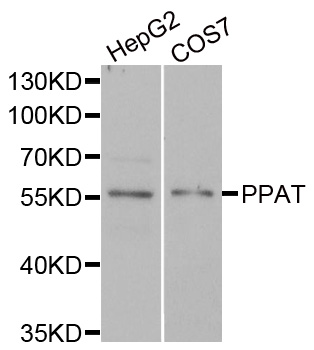Product Name :
PPAT polyclonal antibody Background :
Atase (amidophosphoribosyltransferase), also known as PPAT (phosphoribosyl pyrophosphate (PRPP) amidotransferase), PRAT or GPAT (glutamine phosphoribosyl pyrophosphate amidotransferase), is a ubiquitously expressed N-terminal nucleophile-type glutamine amidotransferase that belongs to the purine/pyrimidine phosphoribosyltransferase family. Existing as a homotetramer, Atase plays an important role in purine metabolism. More specifically, Atase functions as regulatory enzyme and contains one glutamine amidotransferase type-2 domain. Binding a magnesium ion and a 4Fe-4S cluster as cofactors, Atase catalyzes the first step (the rate-limiting step) in the purine nucleotide biosynthesis pathway, a two-step reaction that results in the formation of phosphoribosylamine from PRPP and glutamine. The first step of this reaction is catalyzed by the N-terminal glutaminase domain while the second step is catalyzed by the C-terminal PRTase domain. Product :
Rabbit IgG, 1mg/ml in PBS with 0.02% sodium azide, 50% glycerol, pH7.2 Storage&Stability :
Store at 4°C short term. Aliquot and store at -20°C long term. Avoid freeze-thaw cycles. Specificity :
PPAT polyclonal antibody detects endogenous levels of PPAT protein. Immunogen :
Recombinant full length Human PPAT. Conjugate :
Unconjugated Modification :
Unmodification
PPAT polyclonal antibody Background :
Atase (amidophosphoribosyltransferase), also known as PPAT (phosphoribosyl pyrophosphate (PRPP) amidotransferase), PRAT or GPAT (glutamine phosphoribosyl pyrophosphate amidotransferase), is a ubiquitously expressed N-terminal nucleophile-type glutamine amidotransferase that belongs to the purine/pyrimidine phosphoribosyltransferase family. Existing as a homotetramer, Atase plays an important role in purine metabolism. More specifically, Atase functions as regulatory enzyme and contains one glutamine amidotransferase type-2 domain. Binding a magnesium ion and a 4Fe-4S cluster as cofactors, Atase catalyzes the first step (the rate-limiting step) in the purine nucleotide biosynthesis pathway, a two-step reaction that results in the formation of phosphoribosylamine from PRPP and glutamine. The first step of this reaction is catalyzed by the N-terminal glutaminase domain while the second step is catalyzed by the C-terminal PRTase domain. Product :
Rabbit IgG, 1mg/ml in PBS with 0.02% sodium azide, 50% glycerol, pH7.2 Storage&Stability :
Store at 4°C short term. Aliquot and store at -20°C long term. Avoid freeze-thaw cycles. Specificity :
PPAT polyclonal antibody detects endogenous levels of PPAT protein. Immunogen :
Recombinant full length Human PPAT. Conjugate :
Unconjugated Modification :
Unmodification
-
 WesternBlot (WB) analysis of PPAT polyclonal antibody
WesternBlot (WB) analysis of PPAT polyclonal antibody
Bioworld Biotech only provide peptides for our antibodies and do not provide additional peptide customization services.
Price/Size :
USD 368/1mg/vial
Tips:
For phospho antibody, we provide phospho peptide(0.5mg) and non-phospho peptide(0.5mg).Describe :
Blocking peptides are peptides that bind specifically to the target antibody and block antibody binding. These peptide usually contains the epitope recognized by the antibody. Antibodies bound to the blocking peptide no longer bind to the epitope on the target protein. This mechanism is useful when non-specific binding is an issue, for example, in Western blotting (WB) and Immunohistochemistry (IHC). By comparing the staining from the blocked antibody versus the antibody alone, one can see which staining is specific; Specific binding will be absent from the western blot or IHC performed with the neutralized antibody.Formula:
Synthetic peptide was lyophilized with 100% acetonitrile and is supplied as a powder. Reconstitute with 0.1 ml DI water for a final concentration of 10 mg/ml.The purity is >90%,tested by HPLC and MS.
Storage:
The freeze-dried powder is more stable. For short time at 2-8°C. For long term storage store at -20°C.
Note :
This product is for research use only (RUO only). Not for use in diagnostic or therapeutic procedures.
 PPAT polyclonal antibody
PPAT polyclonal antibody  Datasheet
Datasheet COA
COA MSDS
MSDS SHIP
SHIP